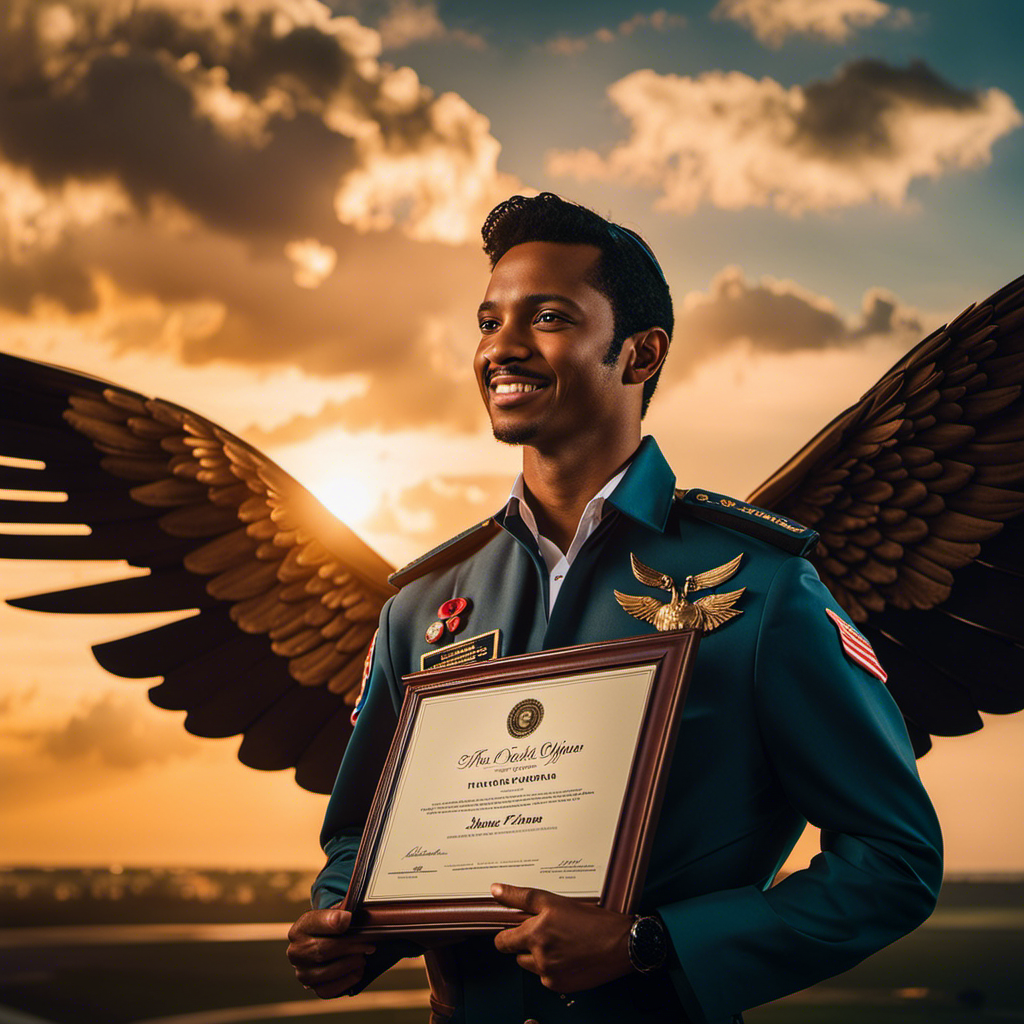Flying through the endless sky, the feeling of weightlessness while in flight fills me with an indescribable sense of freedom and purpose. Being a commercial pilot is not just a job; it is a profound passion.
In this article, I will guide you through the exhilarating journey of becoming a pilot, from the basics of aviation to obtaining your pilot license. Join me as we explore the challenges, rewards, and the endless possibilities that come with a career in the clouds.
Key Takeaways
- Understanding aviation technology and safety is crucial for a commercial pilot.
- The training process involves choosing a flight school, considering safety records and cost, and gaining practical experience through flight hours.
- Advancing in the career includes obtaining pilot licenses, building flight experience, and becoming a certified flight instructor.
- Maintaining and enhancing pilot skills requires recurrent training, staying updated with aviation regulations, and gaining flight experience through entry-level pilot jobs.
The Basics of Aviation
You’ll need to understand the basics of aviation before you can become a commercial pilot.
Aviation technology plays a crucial role in modern aviation, encompassing the various systems and equipment used in aircraft. From navigation instruments to communication devices, pilots rely on aviation technology to safely operate their aircraft.
Additionally, aviation safety is of utmost importance in the industry. Pilots must be well-versed in safety procedures, including emergency protocols and aircraft maintenance checks. Understanding how to handle different weather conditions and potential hazards is also essential.
By familiarizing yourself with the basics of aviation technology and safety, you’ll lay the foundation for a successful career as a commercial pilot.
Now, let’s delve into the role of a commercial pilot and the skills required to excel in this profession.
The Role of a Commercial Pilot
Flying a commercial aircraft involves a diverse range of responsibilities and requires a high level of skill and professionalism. As a commercial pilot, I am responsible for the safety and well-being of every passenger on board.
Some of the key responsibilities include:
- Conducting pre-flight inspections to ensure the aircraft is in proper working condition.
- Planning and executing flight routes, taking into account weather conditions and air traffic.
- Monitoring and adjusting aircraft systems during the flight to maintain optimal performance.
- Communicating with air traffic control and following their instructions.
- Making critical decisions in emergency situations to ensure the safety of passengers and crew.
To excel in this role, a commercial pilot must possess a combination of technical skills, situational awareness, decision-making abilities, and effective communication skills. Choosing a flight school is an important step in acquiring these skills and preparing for a successful career as a commercial pilot.
Choosing a Flight School
When considering flight schools, it’s important to research their curriculum, instructor qualifications, and safety record.
There are various flight school options available, ranging from local flight schools to larger aviation academies. These schools offer different programs tailored to meet the needs of aspiring pilots.
When researching flight schools, cost considerations should also be taken into account. Tuition fees can vary significantly depending on the school and the type of training program. It’s important to evaluate the overall value for money by considering factors such as flight hours included in the program, additional fees for exams and certifications, and any financial aid or scholarships available.
By carefully evaluating these factors, aspiring pilots can choose the flight school that aligns with their goals and budget.
Now let’s dive into the training process.
The Training Process
When it comes to becoming a commercial pilot, there are several key points to consider during the training process.
Firstly, ground school and theory classes are essential in building a strong foundation of knowledge about aviation regulations, aerodynamics, and navigation.
Secondly, flight simulator training provides a realistic and controlled environment for pilots to practice emergency procedures and develop their flying skills.
Lastly, accumulating flight hours and gaining practical experience is crucial for aspiring pilots to demonstrate their proficiency and readiness for real-world flying.
Ground School and Theory
I’m really enjoying Ground School and learning all the theory behind being a commercial pilot. It’s fascinating to dive deep into the practical application of what we learn in the classroom. Ground School is where we study subjects like aerodynamics, navigation, meteorology, and aircraft systems. We also cover regulations, airspace, and flight planning. The instructors provide us with comprehensive materials and guide us through exam preparation. It’s crucial to grasp these concepts thoroughly as they form the foundation of our knowledge for future flight operations. To give you an insight into the topics we cover, here’s a table summarizing some of the key areas we focus on:
| Subject | Description | Importance |
|---|---|---|
| Aerodynamics | Study of how aircraft move through the air | Fundamental |
| Navigation | Techniques for determining aircraft position | Critical |
| Meteorology | Understanding weather patterns and their impact | Safety implications |
| Aircraft Systems | Components and functions of different aircraft systems | Operational necessity |
| Regulations | Rules and guidelines governing aviation | Legal compliance |
With a solid understanding of these subjects, we can confidently move on to flight simulator training, where we put theory into practice.
Flight Simulator Training
Flight Simulator Training is an essential part of pilot education, allowing us to practice and apply the theory we’ve learned in Ground School. This type of training provides numerous benefits for aspiring pilots.
One of the key advantages is the ability to experience real-life scenarios in a controlled, virtual environment. With virtual reality training, we can simulate various weather conditions, emergency situations, and even different types of aircraft. This helps us develop critical decision-making skills and enhances our ability to handle challenging situations in the air.
Additionally, flight simulators allow us to practice procedures and maneuvers repeatedly, which builds muscle memory and improves overall proficiency. By utilizing flight simulators, we can gain valuable experience before taking to the skies for actual flight hours and practical experience.
Flight Hours and Practical Experience
Practical experience is crucial for aspiring pilots to apply their skills and knowledge gained during flight simulator training. While simulators provide a valuable learning tool, nothing can replace the real-life experience of being in the cockpit. Here are some reasons why practical flight training is essential:
- Building confidence: Actually flying a plane helps develop confidence and decision-making skills in real-time situations.
- Developing situational awareness: Being in the air allows pilots to experience and adapt to different weather conditions, air traffic scenarios, and emergency situations.
- Understanding aircraft systems: Practical training provides hands-on experience with the various systems and components of an aircraft.
- Meeting flight hour requirements: Most pilot licenses require a minimum number of flight hours to be completed.
- Networking opportunities: Practical training allows pilots to connect with experienced professionals and potential employers.
Transitioning into the subsequent section about obtaining your pilot license, it is important to understand the requirements and steps involved in the licensing process.
Obtaining Your Pilot License
When it comes to obtaining your pilot license, there are several important assessments that you must go through. These assessments include written exams and oral assessments, which evaluate your knowledge and understanding of aviation theory and regulations.
Additionally, you will also have to undergo flight checkrides and evaluations, where you will be tested on your practical skills and ability to operate an aircraft safely and efficiently.
Written Exams and Oral Assessments
Studying for the written exams and oral assessments is crucial for aspiring commercial pilots. These assessments are designed to ensure that pilots have a comprehensive understanding of the knowledge and skills necessary for safe and efficient flying.
The written exams cover a wide range of topics, including aviation regulations, meteorology, aircraft systems, and navigation procedures. It requires diligent preparation and a deep understanding of the subject matter.
The oral assessments, on the other hand, test the pilot’s ability to communicate effectively and make informed decisions in real-time situations. These assessments often involve scenario-based questions and require candidates to demonstrate critical thinking and problem-solving skills.
Flight Checkrides and Evaluations
To ace your flight checkrides and evaluations, it’s important to demonstrate your practical flying skills and showcase your ability to make split-second decisions in high-pressure situations.
Flight checkrides are crucial for pilot training as they allow instructors to evaluate your performance and ensure that you are capable of safely operating an aircraft. During these checkrides, pilots are evaluated on various aspects, including their knowledge of flight procedures, ability to handle emergency situations, and adherence to regulations.
Evaluators closely observe the pilot’s decision-making skills, communication abilities, and situational awareness. The importance of flight checkrides cannot be overstated, as they provide a realistic assessment of a pilot’s capabilities and readiness for real-world scenarios.
With this foundation in place, pilots can then focus on building flight experience and further honing their skills.
Building Flight Experience
When it comes to building flight experience, two key points to consider are entry-level pilot jobs and becoming a certified flight instructor.
Entry-level pilot jobs provide an opportunity to gain valuable hours in the cockpit and learn the ropes of the industry.
On the other hand, becoming a certified flight instructor allows pilots to not only build flight experience but also pass on their knowledge and skills to aspiring aviators.
Both options offer unique paths for pilots to continue their professional development and pave the way for future career opportunities in aviation.
Entry-level Pilot Jobs
Getting hired for entry-level pilot jobs can be a competitive process. The job market for entry-level pilots is constantly evolving, with factors such as the economy, airline industry trends, and pilot retirements impacting the demand for new pilots.
Entry-level pilot salaries can vary depending on the type of aircraft, the airline, and the location. Starting salaries can range from around $30,000 to $60,000 per year. It’s important to note that these salaries can increase as pilots gain more experience and move up in their careers. However, the initial salary may not be the most important factor for new pilots.
The opportunity to gain flight hours and build experience is often the primary goal. This experience is crucial for pilots looking to advance in their careers or become a certified flight instructor, which allows them to share their knowledge and expertise with aspiring pilots.
Transitioning into the next section, becoming a certified flight instructor is a natural step for many pilots as it provides an avenue to further develop their skills and gain valuable teaching experience.
Becoming a Certified Flight Instructor
After gaining experience as an entry-level pilot, the next step in advancing my career is becoming a Certified Flight Instructor (CFI). This is an exciting opportunity to not only share my knowledge and passion for aviation, but also to enhance my own skills as a pilot. To become a CFI, I will need to undergo specialized instructor training that focuses on teaching techniques specific to aviation. This training will cover a wide range of topics including lesson planning, student evaluation, and effective communication in the cockpit. As a CFI, I will have the responsibility of instructing and mentoring aspiring pilots, helping them develop the knowledge and skills necessary to become successful aviators. Becoming a CFI is a crucial milestone in my journey towards a fulfilling career in the clouds.
| Instructor Training Topics | Teaching Techniques |
|---|---|
| Lesson Planning | Active Learning |
| Student Evaluation | Simulation |
| Communication in Cockpit | Hands-on Training |
| Safety Procedures | Scenario-based |
| Regulations and Guidelines | Instruction |
With the skills and knowledge gained from instructor training, I will be better equipped to guide and mentor future pilots, shaping their journey in the aviation industry. As I progress in my career, there are further opportunities for advancement and specialization.
Advancing Your Career
As you progress in your career as a commercial pilot, you’ll find that networking with other professionals can greatly benefit your advancement. Advancing your career in the aviation industry requires more than just flying skills.
Building connections with fellow pilots, industry experts, and potential employers can open up various career growth opportunities. Attending industry events, joining professional organizations, and utilizing online platforms can help you expand your network and stay updated on the latest industry trends.
Through networking, you may come across mentorship opportunities, job openings, and valuable advice from experienced pilots. By actively engaging with other professionals, you can gain insights into potential career paths, discover new opportunities, and enhance your overall professional development.
Developing a strong network is an essential step towards advancing your career as a commercial pilot and reaching your goals in the aviation industry. It sets the foundation for the subsequent section on maintaining your pilot skills, ensuring a well-rounded approach to career growth.
Maintaining Your Pilot Skills
As a commercial pilot, it’s crucial to prioritize continuing education and recurrent training to maintain and enhance your pilot skills. This ongoing education ensures that you stay up-to-date with the latest aviation regulations and industry best practices.
Continuing Education and Recurrent Training
To stay up-to-date in your career as a commercial pilot, you must undergo recurrent training to ensure your skills and knowledge are constantly refreshed. Continuing education is a crucial aspect of being a pilot, as it allows you to stay current with the latest safety measures and industry standards.
Recurrent training typically involves a combination of classroom instruction, simulator sessions, and flight evaluations. These training sessions cover a wide range of topics, including emergency procedures, aircraft systems, and navigation techniques.
Staying Up-to-Date with Aviation Regulations
You need to stay current with aviation regulations in order to ensure the safety and efficiency of your operations. Staying updated on aviation rule changes can be a challenge, but it is vital for every commercial pilot. Regulatory compliance challenges arise as new rules and regulations are introduced, and it is crucial to stay informed and adapt accordingly. To help you understand the importance of staying up-to-date, here is a table highlighting a few key regulations that commercial pilots must comply with:
| Regulation | Description | Compliance Date |
|---|---|---|
| FAR Part 91 | General operating and flight rules | Ongoing |
| FAR Part 135 | Operations conducted under charter or on-demand | Ongoing |
| ICAO Annexes | International standards and recommended practices | Ongoing |
| TSA Security | Measures to enhance aviation security | Ongoing |
| FAA ADs | Airworthiness directives for aircraft maintenance | Ongoing |
As a commercial pilot, it is essential to review and understand these regulations to ensure a safe and successful career. Staying current with aviation regulations is just one of the many challenges and rewards of being a commercial pilot.
Challenges and Rewards of Being a Commercial Pilot
As a commercial pilot, one of the challenges I face is dealing with long hours and jet lag. The demanding nature of the job often requires me to fly for extended periods of time, crossing multiple time zones. This can result in disrupted sleep patterns and fatigue, but I have learned effective strategies to mitigate these effects and ensure I am always alert and focused in the cockpit.
Additionally, being a pilot allows me to experience the thrill of flying firsthand. The feeling of taking off into the sky and maneuvering through the clouds is exhilarating and never gets old.
Lastly, one of the most rewarding aspects of being a commercial pilot is the travel opportunities it provides. I have had the chance to visit various destinations around the world, exploring different cultures, cuisines, and landmarks, all while doing what I love.
Dealing with Long Hours and Jet Lag
When flying long hours as a commercial pilot, it’s important to find strategies to cope with jet lag. As a pilot, my health and well-being are crucial to ensure a safe and efficient flight. Here are three coping strategies I utilize to combat jet lag:
-
Establishing a sleep routine: I try to maintain a consistent sleep schedule, even during layovers, to help regulate my body clock.
-
Staying hydrated: Drinking plenty of water throughout the flight helps to keep me hydrated and minimize the effects of jet lag.
-
Adjusting to local time: Upon arrival, I make an effort to adapt to the local time zone as quickly as possible, aligning my sleep and meal times accordingly.
By implementing these coping strategies, I can minimize the impact of jet lag and maintain my health and well-being during long flights.
With these strategies in place, I am better able to enjoy the thrill of flying and the exciting travel opportunities that come with being a commercial pilot.
Enjoying the Thrill of Flying and Travel Opportunities
Embrace the exhilaration of flying and the endless possibilities for adventure and exploration that await.
As a commercial pilot, not only do I get to experience the thrill of being in command of an aircraft, but I also enjoy the travel benefits and professional development opportunities that come with the job.
One of the greatest perks of being a pilot is the ability to travel to different destinations around the world. From bustling cities to exotic islands, I have the privilege of visiting new places and immersing myself in different cultures. This not only broadens my horizons but also provides me with invaluable life experiences.
Additionally, being a commercial pilot offers numerous professional development opportunities, such as advanced training courses, aviation conferences, and networking events. These opportunities allow me to continuously expand my knowledge and skills, keeping me at the forefront of the industry.
As I reflect on the excitement of flying and the travel benefits and professional development opportunities that come with it, I am reminded of the importance of following one’s passion and embracing the endless possibilities that await.
Final Thoughts and Advice
When it comes to pursuing a career in aviation, two key points to consider are networking and building professional connections, as well as pursuing your passion for aviation.
Networking is crucial in the aviation industry because it allows you to meet and connect with professionals who can potentially open doors for you and provide valuable guidance and opportunities.
Additionally, pursuing your passion for aviation is essential because it will fuel your motivation and drive to excel in your chosen field, making your career journey more fulfilling and rewarding.
Networking and Building Professional Connections
Networking and building professional connections is crucial for aspiring commercial pilots in order to gain valuable industry insights and opportunities. Attending networking events and utilizing online platforms are two effective ways to expand your network and connect with industry professionals.
Networking events provide the opportunity to meet and engage with pilots, aviation experts, and potential employers. These events often feature panel discussions, workshops, and presentations that offer valuable information and advice for aspiring pilots.
Additionally, online platforms such as LinkedIn and aviation-specific forums allow pilots to connect with professionals from around the world, share experiences, and learn from each other.
Pursuing Your Passion for Aviation
Pursuing your passion for aviation involves continuously seeking opportunities to expand your knowledge and skills in the industry. As a pilot, there are various career options available to you, each with its own set of requirements and opportunities. To navigate the ever-evolving aviation industry, it’s important to stay updated on the latest trends.
Here are some key trends to consider:
-
Technological advancements: The aviation industry is embracing new technologies, such as automation and artificial intelligence, to enhance safety and efficiency.
-
Sustainable aviation: With increasing environmental concerns, there is a growing focus on reducing carbon emissions and adopting sustainable practices.
-
Global demand: The demand for pilots is expected to rise globally, especially in emerging markets.
-
Diversification: Besides commercial airlines, there are opportunities in cargo, private jets, and even drone piloting.
Frequently Asked Questions
What are the physical requirements to become a commercial pilot?
To become a commercial pilot, you must meet certain physical requirements and have good overall health. This includes having excellent vision, normal blood pressure, good hearing, and being free from any conditions that could affect your ability to fly safely.
How long does it typically take to complete flight training and obtain a pilot license?
Flight training duration can vary, but on average it takes about 6-12 months to complete. Obtaining a pilot license typically requires completing a minimum of 40-60 flight hours, passing written exams, and meeting medical and flight experience requirements.
Are there any specific medical conditions that would disqualify someone from becoming a commercial pilot?
Certain medical conditions may prevent individuals from pursuing a career as a commercial pilot. Aspiring pilots must undergo a thorough medical evaluation, which assesses their fitness to fly and identifies any disqualifying conditions.
What are the career prospects and job opportunities for commercial pilots?
Career advancement in the field of commercial aviation is promising, with numerous job opportunities available globally. The demand for commercial pilots is high, creating a favorable outlook for those looking to pursue a career in this industry.
How much does it cost to become a commercial pilot, including flight training and obtaining a pilot license?
How much does it cost to become a commercial pilot? The cost of flight training and obtaining a pilot license can vary, but financial assistance options like scholarships and loans are available to help aspiring pilots achieve their dreams.
Conclusion
In conclusion, embarking on a career in the clouds as a commercial pilot is an exhilarating journey filled with endless possibilities. The challenges faced along the way may seem daunting, but they serve as stepping stones towards personal growth and professional success.
With dedication and perseverance, one can navigate through the skies, exploring new horizons and embracing the rewards that come with this noble profession.
So, spread your wings and soar high, for the sky is not the limit, but rather an invitation to reach for the stars.









